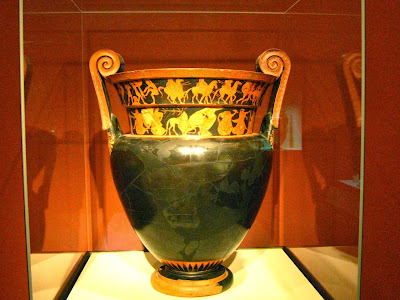Tightwad travel does not always involve major trips to foreign countries. David and I love thirty-hour trips for maximum pleasure at a minimal price. Last week, for $18 each, we first visited an ancient Roman villa, modeled after one dating back to 79 AD, and then went even further back in time to see the animals that roamed the earth during the last of the four Ice Ages at the end of the Pleistocene Epoch. Staying over night in Venice Beach, modeled after Venice, Italy, and home to the Beat Generation during the 50s and 60s, provided the perfect nostalgic grace note to our entire back-in-time trip.
Our first stop Wednesday was the J Paul Getty Villa. Getty, while not exactly a tightwad, was indeed a traveler. He earned his first million in the United States by the time he was 24, but amassed most of his fortune, making him one of the richest men in America, by acquiring oil fields in Saudi Arabia and Kuwait. He also traveled to Greece and Rome where he became an avid collector of antiquities.
When his collection exceeded the exhibition space in his home, Getty built a replica of the Villa dei Papiri, the summer home of Julius Caesar's father-in-law in Herculaneum, Italy. Although both Pompeii and Herculaneum were destroyed in 79 AD by Vesuvius's volcanic eruption, excavations had revealed the design of this gracious mansion. The reproduction, which today stands on a hillside in Malibu, must surely be almost as beautiful as the original.
The approach to the museum simulates an archaeological dig with poured concrete walls that replicate strata of rock. Walking through the extensive herb garden or one of the other decorative gardens, you gradually approach the structure itself with its marble floors, painted ceilings, and decorative walls that were typical of Roman and Greek structures of the time.
Floor Detail - Getty Villa
Ceiling Detail - Getty Villa
All of the components of the original villa have been replicated from the Inner Peristyle, a courtyard with a columned porch, to the Outer Peristyle garden with its reflecting pool. And, of course, the small rooms of the first floor and the entire second floor are devoted to showcasing the antiquities that Getty accumulated during his lifetime.
A Greek Vessel
A Garden at the Getty Villa
The Inner Peristyle
The Outer Peristyle
Our stop the next day was the Page Museum and La Brea Tar Pits which were made possible by George Page. When he was twelve, Nebraska-born Page was smitten when he tasted his first orange. He decided he had to live where these luscious fruits were grown, so, at sixteen he became a tightwad traveler and eventually worked his way to California. He held a series of menial jobs, ate oranges, and eventually saved a thousand dollars to begin his own business—selling California fruit in a “Mission Pak” to people in colder climates. He later manufactured sports cars and dabbled in real estate until he amassed the fortune which enabled him to build the Page Museum showcasing the La Brea Tar Pits.
The Tar Pits, particularly sticky when warm, entrapped animals that came in search of water. When other animals heard the cries of the immobilized victims that were dying of starvation and dehydration, they attacked and became enmeshed in the sticky goo themselves. Thus, one large mammal might attract an entire food cycle chain with all them dying in the end. This cycle was repeated for over 30,000 years.
Depiction of Animal Caught in Tar Pit
Because tar is a particularly effective preservative, digs in the tar pits have unearthed the largest and most diverse collection of Ice Age animal bones in the world. From the bones that have been recovered, saber tooth cats, dire wolves, mastodons and some eagle species of birds, all now extinct, were re-constructed and are now exhibited in the museum.
A Tar Pit Victim
Current Dig Site - Pit 91
Venice Beach, where David and I spent Wednesday night, does not contain antiquities or prehistoric animals, but it is a slice of Americana. Developed in 1905 by Abbot Kinney, the “Venice of America” project turned swamp land into canals meant to mimic its more famous namesake. Beatniks, poets, artists, and actors have walked its famous boardwalk and called it home for more than fifty years.
Venice Beach
The Canals
The label above the fountain reads, "The World's Smallest Front Yard." This house on the boardwalk has a mirrored front, a narrow "reflecting pool," a strip of grass about 2 x 24 inches, and a fountain.
The flimsy houses which once lined the canals have been replaced by two million dollar extravaganzas, but the town and the boardwalk still retain the funky charm that made this place famous.
David and I returned to San Diego Thursday evening feeling as though we'd been gone thirty days, not thirty hours. After all, we'd taken a tour of ancient Herculaneum, come face to face with extinct animals from the Ice Age, and strolled the quirky streets and boardwalk of Venice. We did an entire trip back in time, and yet we were still home in time for supper!
Practicalities -
Admission to the Getty Villa, open Tuesday through Sunday, is free, but you must get a timed ticket in advance. Parking in the Getty lot costs $15. See this site for more information: http://www.getty.edu/visit/
Admission to the Page Museum and Tar Pits, open daily, is $7 for adults. Parking costs $9, but $2 is reimbursed when your ticket is validated by the museum. See this site for more information: http://www.getty.edu/visit/














No comments:
Post a Comment